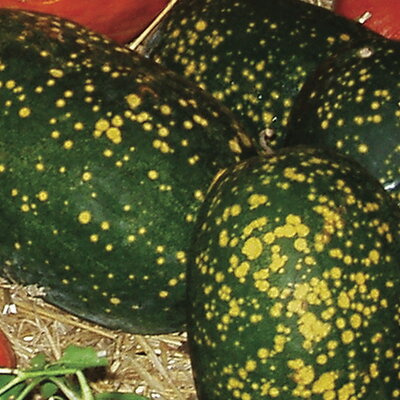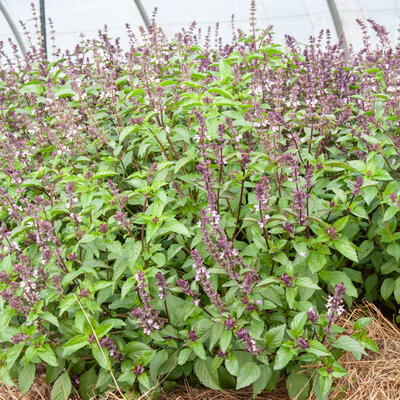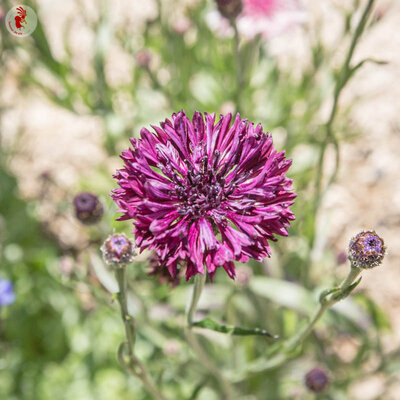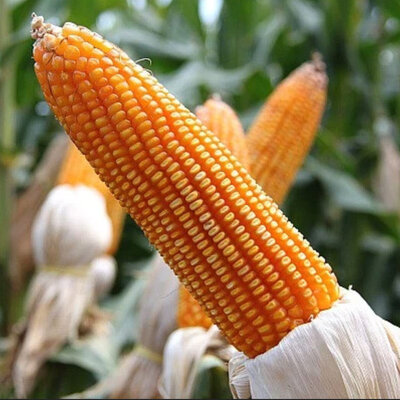
Amish Moon-Stars - Watermelon
The Moon and Stars watermelon is an old variety with "star" speckled foliage, producing elongated fruit weighing 6 to 12 kg. Their green skin is studded with yellow spots in the shape of "stars" and "moons". Their pinkish-red flesh has a pleasantly sweet taste. Seeds are brown.
Characteristics of the watermelon Moon and Stars - Lune-Étoiles Amish
The Moon and Stars watermelon, Citrullus lanatus, is a variety of fruiting vegetable native to the United States. It is probably a variant of the "Sun, Moon and Stars" watermelon proposed by Henderson in 1920, and reintroduced in 1987 by the Seed Savers Exchange. This runner variety owes its name to its elongated fruits, weighing from 6 to 12 kg, spotted with moon and yellow stars. Their thick green skin encloses sweet red flesh and brown seeds.
Moon and Stars watermelon seedlings - Lune-Étoiles Amish
Moon and Stars watermelons are sown in pots of 2 to 3 seeds, 6 to 8 weeks before transplanting, from March to April. Place seedlings under a bright, warm shelter, at a temperature above 21°C, and keep the substrate moist until the seeds emerge. Transplant watermelons to the vegetable garden once the last frosts have passed. From April to May, after the last risk of frost, it's possible to sow directly in the garden in stacks of 2 to 3 seeds.
Prepare holes filled with compost or organic matter 2 weeks in advance, spaced 1.50 m apart in all directions, to accommodate the watermelon plants or seeds. In cooler regions, it's advisable to warm the soil with mulch before planting, and to leave only one to three fruits per plant to encourage the ripening process. To encourage height growth and free up space on the ground, install sturdy supports when transplanting the plants.
Water freshly transplanted seedlings regularly, avoiding wetting the foliage, and mulch the soil to keep it cool and limit water evaporation. In the vegetable garden, watermelon enjoys the company of potatoes, leeks and onions.
Harvesting Moon and Stars watermelon - Lune-Étoiles Amish
Moon and Stars watermelons are harvested from July to October, when the fruit is heavy and the tendril opposite the stalk is dry. Be careful not to tear off the fruit, but cut as close to the stem as possible, 10 cm above the stalk. Watermelons do not ripen after picking. They can be stored for several days in a cool, dark place.
These products may also be of interest to you
in bucket, in the ground
Sow in pots at 20-30°C, 6 weeks before planting. Transplant with the root ball, after the last frosts, in planting holes enriched with compost, spaced 1.5 m apart in all directions. Sowing in the open ground is possible under the same conditions, once the soil has warmed up and outside temperatures have not dropped below 15°C.
March, April, May
April, May
July, August, September, October
in the ground, in the greenhouse
sunny
medium
sandy, humus
rich, reheated, drained
Citrullus lanatus
mid-season
From 6000 to 12000 g
15 seeds
elongated
farm
Red
From 100 to 200 cm
From 40 to 60 cm
runner
cut
United States
Inconnue
"Semences de Kokopelli" by Dominique Guillet
This old variety was reintroduced in 1987 by the Seed Savers Exchange. It is probably a variant of the "Star Moon" watermelon introduced by Henderson in 1920.
Henderson
Watermelon contains almost 92% water and little fiber, making it easier to digest for people with sensitive intestines. Rich in lycopene, an antioxidant that gives it its red color, it has cholesterol-lowering, anti-inflammatory and cell-protecting properties. Its content of amino acids and vitamin C contributes to a healthy immune system. The seeds are also rich in vitamin C, proteins, carbohydrates and lipids.











